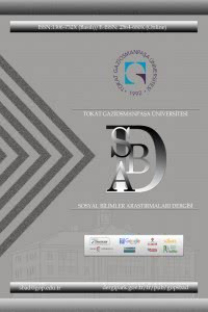Hâce Muhammed Lütfî’nin (Alvarlı Efe) Şiirlerinde Cemâl Müşahedesinin Yansımaları
The Reflections of The Contemplation of The Absolute Divine Beauty (Camâl-i Ilâhî) in Hâcah Muhammad Lutfi’s Poems
Transcending, Similarity, The Self-Disclosure, Absolute Divine Beauty (Camâl-i Ilâhî), Contemplation, Divine Love.,
___
- Alvarlı Efe, Hâce Muhammed Lutfi (2011), Hulâsatü’l-Hakâyık, (Damla Yay.), İstanbul.
- Chittick, William C. (2003), Tasavvuf, Kısa Bir Giriş, çev. Turan Koç, (İz Yay.), İstanbul.
- Çakmaklıoğlu, M. M. (2007), İbn Arabî’de Ma’rifetin İfadesi, (İnsan Yay.), İstanbul.
- Eroğlu, Farsakoğlu A. (2010), Hâce Muhammed Lutfî’nin Şiirlerinde Din ve Tasavvuf Kültürü, (Akademi Yay.), İzmir.
- İbn Arabî, (1999), Muhyiddin, el-Fütûhâtü’l-Mekkiyye, haz., Ahmet Şemsettin, (Daru’l-Kütübi’l-İlmiyye), Beyrut.
- İbn Arabî, (1946), Fusûsu’l-Hikem,thk. Ebu’l-Alâ Afifi, (Dâru İhyâi’l-Kütübi’l- Arabiyye), Kahire.
- İbn Arabî, (2000), Zehairu’l-Â’lâk Şerhu Tercümâni’l-Eşvâk, hz. Halil İmran Mansur, (Dârü’l-Kütübi’l-İlmiyye), Beyrut.
- İbn Arabî, Ankâu Mugrib, thk. Ahmed Seyyid Eş-Şerif, (Mektebetü’l-Ezheriyye li’t-Türas), Kahire, ts.
- İbn Arabî, Kitâbu’t-Terâcim, Resâilu İbn Arabî, thk., Muhammed İzzet, (Mektebetü’t-Tevfikiyye), Kahire, ts.
- Kartal, A. (2003), Abdülkerim el-Cîlî, Hayatı Eserleri, Tasavvuf Felsefesi, (İnsan Yay.), İstanbul.
- el-Kayserî, (2011), Dâvûd, Aşk Şarabı ve Hayat, Kasîde-i Hamriyye Şerhi, terc. Turan Koç-Mehmet Çetinkaya, (İnsan Yay.), İstanbul.
- Kemikli, B. (2011), Sûfi Şâirin İzinde Şiir ve İrfan, (Kitabevi Yay.), İstanbul.
- Kemikli, B. (2004), Dost İlinden Gelen Ses, (Kitabevi Yay.), İstanbul.
- Koç, T. (2008), İslam Estetiği, (İSAM), İstanbul.
- Kılıç, M. E. (2004), Sûfi ve Şiir, (İnsan Yay.), İstanbul.
- Kuşeyrî, (2001), er-Risâletü’l-Kuşeyriyye, tahk. Halil Mansur (Daru’l-Kütübi’l- İlmiyye), Beyrut.
- Kutlu, H. (2006), Hâce Muhammed Lutfî, Hayatı, Eserleri ve Şahsiyeti, (Damla Yay.), İstanbul.
- Küçük, O. N. (2011), Fusûsü’l-Hikem ve Mesnevî’de İnsan-ı Kâmil, (İnsan Yay.), İstanbul.
- Mevlânâ, Celâleddin Rumi, (1960), Mesnevî, çev. Veled İzbudak, (MEB. Yay.), İstanbul.
- Mevlânâ, Celâleddin Rumi, (1994), Rubâiler I-II, çev. M. Nuri Gençosman, (MEB. Yay.), İstanbul.
- Nasr, Seyyid Hüseyin, (2001), Bilgi ve Kutsal, çev. Yusuf Yazar, (İz. Yay.), İstanbul.
- Nicholson, Reynold A. (1969), fi’t-Tasavvufî’l-İslâmî ve Târîhuhu, Arapça’ya çev. Ebu’l-Alâ Afîfi, (Lecnetü’t-Te’lîf ve’t-Tercüme ve’n-Neşr), Kahire.
- Nicholson, Reynold A. (1975), The Mystics of Islam, (Schocken Books), New York.
- eş-Şutûrî, Ali Hatîb, (1984), İtticâhü’l-Edebi’s-Sûfî Beyne Hallâc ve İbn Arabi, (Dârü’l-Meârif), Kahire.
- et-Tehânevî, Muhammed Ali, (1996), Keşşâfu Istılâhâti’l-Fünûn ve’l-Ulûm, tahk., Refîk el-Acem, (Mektebetü Lübnân), Beyrut.
- ISSN: 1306-732X
- Yayın Aralığı: 2
- Başlangıç: 2006
- Yayıncı: Gaziosmanpaşa Üniversitesi Sosyal Bilimler Enstitüsü
Tarihi Yapılarda Yeniden Kullanım Sorunları Tokat Meydan ve Sulu Sokak
Örgütsel Değişim Sürecinde Öğrenen Örgütler ve Örgüt Geliştirme
AB ve Türkiye’de Tarım Sektöründe Örgütlenme ve Üretici Birlikleri
Halil KIZILASLAN, Hasan Gökhan DOĞAN
İslam Tarihinde Vakıf Kültürü Üzerine Bir İnceleme
Hâce Muhammed Lütfî’nin (Alvarlı Efe) Şiirlerinde Cemâl Müşahedesinin Yansımaları
Çimento Sektöründe Özelleştirmelerin İşletme Performansına Etkileri (Türkiye Uygulaması)
Tüketicilerin Açık Süt ve Süt Ürünleri Tüketim Tercihlerinin İncelenmesi: Tokat-Turhal İlçesi Örneği
